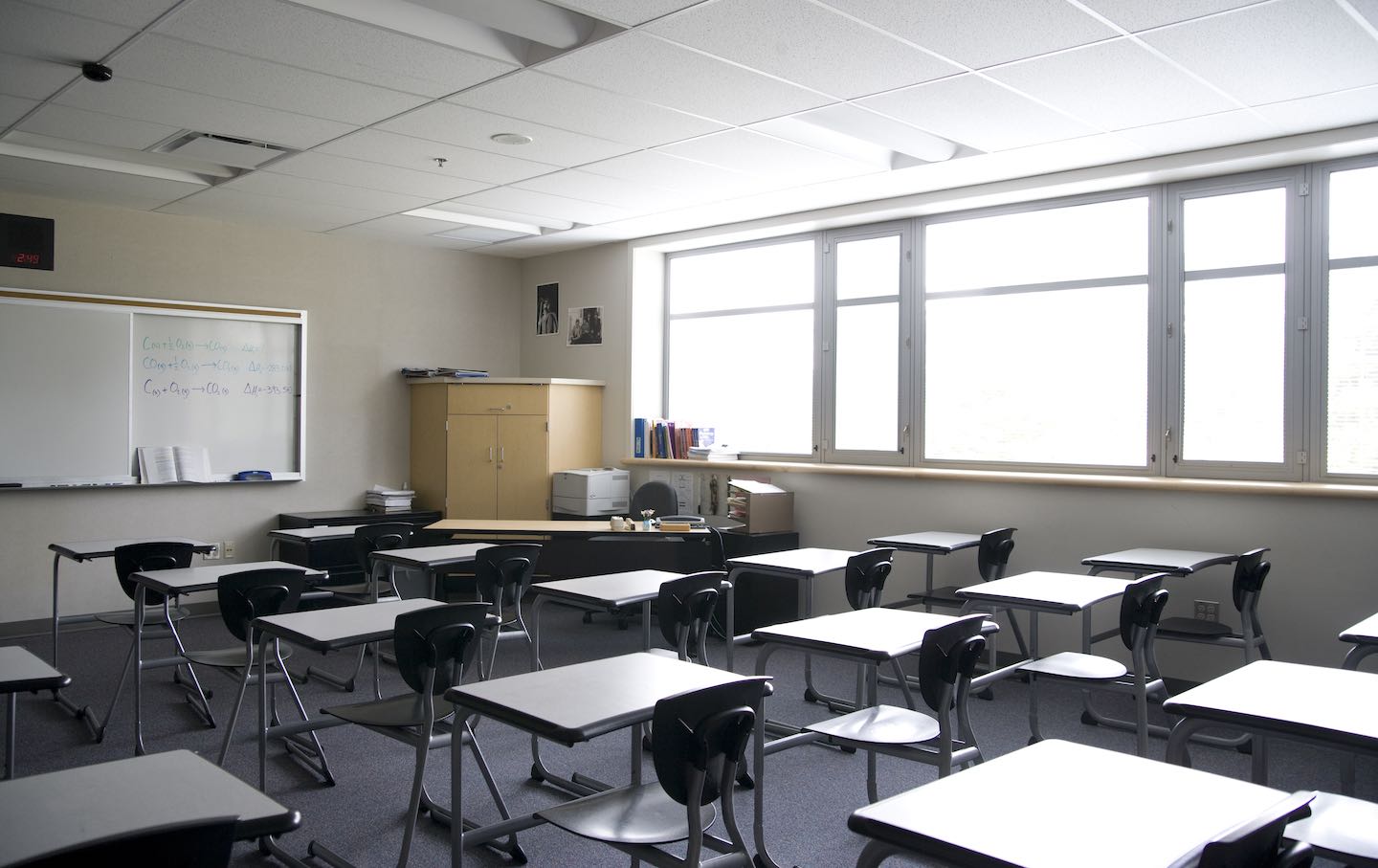
[ad_1]
Politics
/
Left Coast
/
May 17, 2024
The money-saving measure happening in districts throughout the country leaves too many kids without anything to do—or in some cases, anything to eat.

Late last month, while I was reporting a story on the election season in Arizona, I met a voter registration volunteer named Nick Ethier at a farmers market on the outskirts of Phoenix. Ethier had a 14-year-old daughter, who was enrolled in middle school in the community of Buckeye, part of the Liberty School District. Liberty was one of six districts in the Phoenix Metropolitan area to vote down school bond requests for supplemental dollars to keep its schools running properly. While the 12 districts that voted in favor of the bond request have been able to maintain their education standards, the six that didn’t are facing all kinds of budgetary shortfalls. Liberty has chosen to deal with this by adopting a four-day school week.
Arizona ranks 48th out of the 50 states in per-pupil education spending, committing only 66 percent of the national average to its students’ schooling. Like many states, it is facing a looming education crisis. Arizona is underinvesting in basic educational needs, and, instead of raising taxes or bond revenue, it is letting districts take shortcuts on education that will likely have a calamitous impact down the road. Neighboring Nevada, which, along with Oklahoma, is one of the only two states spending even less per kid on K-12 education than Arizona, is in a similar predicament.
Every Friday, Nick’s daughter just sits at home. On those days, Nick says, she does “nothing.” She gets no homework and has no online educational activities. Instead, the school district has simply rolled back its responsibilities to kids on Fridays. In theory, shorter school weeks could be a force for good—if, say, children had the resources and inclination to spend their spare days roaming the great outdoors or visiting museums. But in practice, less school time often means more time online, more stress for parents, and less food security, since large numbers of children rely on free school breakfasts and lunches for much of their daily sustenance.
It turns out that Liberty’s “solution” to its funding crisis is by no means unique. In fact, the number of school districts adopting four-day weeks is on the rise in post-pandemic America. Districts that pay low wages to teachers and to support staff have increasingly struggled to hire enough personnel, and anti-government sentiment, especially in conservative rural areas, has made it more likely that voters will reject bond measures to properly fund their schools.
The four-day week is marketed as a way for small school districts to save money—and to lure teachers in without having to pay them decent salaries that would properly compensate for a five-day workweek. In Oklahoma, districts are now allowed to schedule fewer than 180 days per year of classroom instruction. That’s two full weeks per year less school time than, say, a German student gets. Over the course of twelve years of schooling, that adds up to nearly six months less education. The phenomenon is seen disproportionately in western states, particularly in smaller districts, and in regions of the country that have historically underinvested in education infrastructure.
Not surprisingly, the results aren’t exactly uplifting. A RAND study from 2021 found that these four day weeks impacted student learning, reducing the amount of improvement in English and math that students chalked up each year. A number of other studies have reached similarly bleak conclusions. As it turns out—all the hype about Zoom and remote learning notwithstanding—most kids, generally speaking, need to be in classrooms, listening to real flesh-and-blood teachers and surrounded by real flesh-and-blood students, in order to fully absorb their lessons.
Current Issue

Schools across the US emerged from pandemic school shutdowns, lasting anywhere from months to years, plagued by an educational epidemic of chronic absenteeism. The basic notion that school was mandatory rather than optional was shattered by the school closure policies. Even in a best-case scenario, it will take years for the culture of absenteeism and its consequences to fully run their course. In light of this crisis, schools should be doing everything in their power to increase the number of days per year that students receive an education. Instead, many penny-pinching school districts are stampeding in the opposite direction.
It’s desperately short-sighted, not just for the kids and their well-being, but for the economic security of the communities involved. Studies have found that when districts adopt the four-day school week, it soon leads to measurable declines in home values in these districts, as parents shun buying there in favor of places that still have five-day weeks.
For Nick, trying to register young adults to vote as the election nears, there is an obvious connection between the decline in educational involvement and the broader crisis of civic disengagement. Some young men coming out of high schools “don’t seem to care about voting,” he says. “They couldn’t care less. Voter registration? They tune out and walk on by. Generally, the guys between high school age and 35 to 40, if they don’t have kids, they don’t care. They don’t care about politics or voting, or even know what’s going on. It’s that machismo, youthful ignorance, whatever you want to call it.”
Thank you for reading The Nation!
We hope you enjoyed the story you just read, just one of the many incisive, deeply reported articles we publish daily. Now more than ever, we need fearless journalism that moves the needle on important issues, uncovers malfeasance and corruption, and uplifts voices and perspectives that often go unheard in mainstream media.
Donate right now and help us hold the powerful accountable, shine a light on issues that would otherwise be swept under the rug, and build a more just and equitable future.
For nearly 160 years, The Nation has stood for truth, justice, and moral clarity. As a reader-supported publication, we are not beholden to the whims of advertisers or a corporate owner. But it does take financial resources to report on stories that may take weeks or months to investigate, thoroughly edit and fact-check articles, and get our stories to readers like you.
Donate today and stand with us for a better future. Thank you for being a supporter of independent journalism.
Thank you for your generosity.
Sasha Abramsky
Sasha Abramsky, who writes regularly for The Nation, is the author of several books, including Inside Obama’s Brain, The American Way of Poverty, The House of 20,000 Books, Jumping at Shadows, and, most recently, Little Wonder: The Fabulous Story of Lottie Dod, the World’s First Female Sports Superstar. Subscribe to The Abramsky Report, a weekly, subscription-based political column, here.
[ad_2]